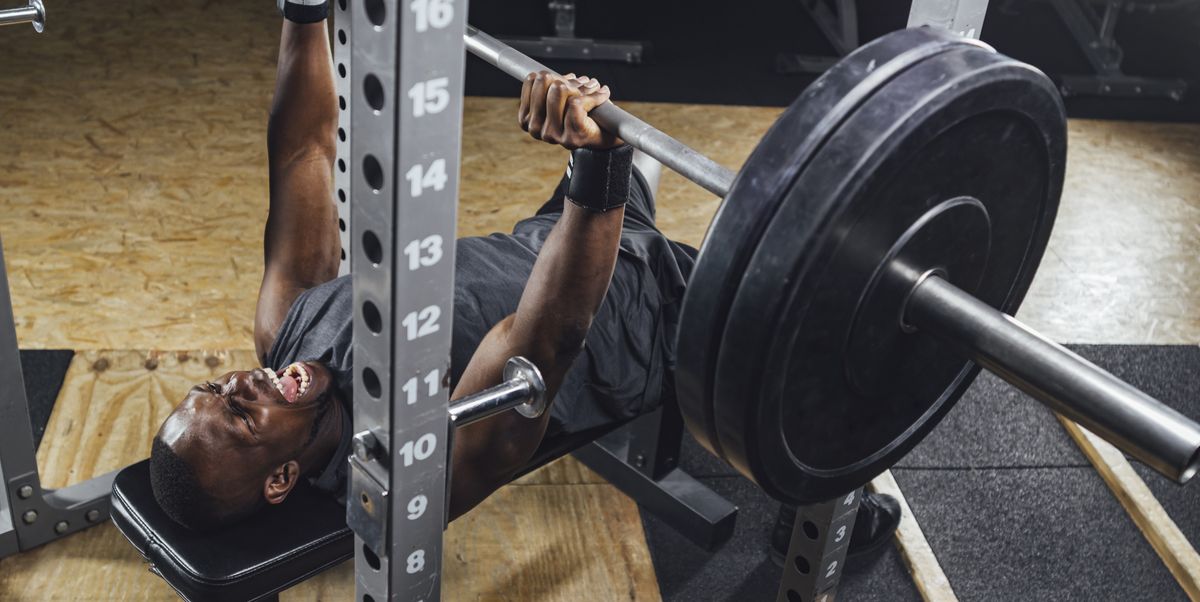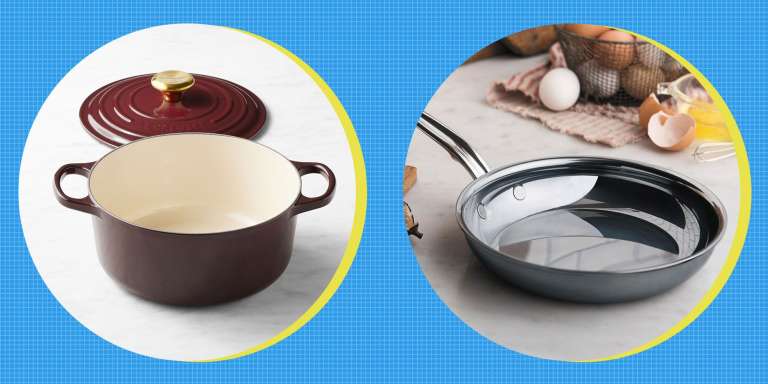How Much Weight Should I Be Able to Bench Press, Really?

ED Help
FOR AS LONG as men have clanked platters of iron onto barbells, the bench press has been a strength benchmark. Some guys swear that you’re nothing unless you can push two plates, minimum. Others insist you should be able to press your bodyweight—or even double that.
The reality? “There’s nothing magic about the bench. We use it as a marker of upper body strength, but your back can be pretty damn strong, too,” says Shawn Arent, Ph.D., C.S.C.S., chair of the Department of Exercise Science at the University of South Carolina. “In some ways, we might be able to make a better case for how many pushups you should be able to do [as a gauge of strength].”
That’s because, unlike the bench press, pushups express relative strength since you’re working with your own bodyweight. There are factors that make barbell bench pressing less easy to gauge across different bodies, which we’ll cover momentarily.
But even if this classic exercise isn’t the most logical to use as a universal measuring stick, it’s still got a hold on many a gym-going guy for one simple reason: You’ll more than likely be able to work with more weight with the barbell bench press than any other upper body exercise. If that appeals to you and makes you show up in the weight room, that’s magic enough.
How Much Weight Men Should Be Able to Bench Press
There is no right answer to the question of how much weight you should be able to barbell bench press, for a wide variety of reasons. Your ability here has more to do with individual factors like your goals, fitness level, training age (how long you’ve been consistently working out), and your particular anatomical makeup than any universal standard. Yes, there will be milestones you can hit, like repping out 225 pounds like you’re at the NFL Combine, pressing your bodyweight, or stacking extra plates—but those are all dependent on you.
Still, it’s a question that just about any guy who enters a weight room has asked himself. Here’s how much Arent and Kurt Ellis, C.S.C.S., owner of Beyond Numbers Performance, think you should set as your bench standard, along with some tips to build towards those numbers. And if you’re not into—or able to—bench, they’ve got some muscle and strength-building tips for you, too.
Bench Press Standards You Can Use
You’ll find innumerable calculators and charts online telling you how much weight you should be aim to barbell bench press. These can be helpful in some ways, especially if they’re tied to a specific program you’re following—but if you’re not doing that, they’re only useful up to a point. They’re also not exact, spitting out weights that you can’t even load onto your gym’s barbell, like 194 pounds.
Arent suggests keeping your expectations simpler: “If you can bench press your body weight, you’re doing pretty good,” he says. “If you’re a powerlifter, you’ll be able to do much more than that. But for most people, that’s a pretty impressive thing to do.”
If you’re new to the iron game, though, you shouldn’t expect to be able to roll up on day one and press a bar that weighs as much as you. And you shouldn’t expect to lift that much within the first year, according to Ellis. “Generally speaking, if we’re looking at a beginner with between zero months of training and a year, being able to bench at least half your body weight is a good goal,” he says.
Ellis suggests using a tiered goal system based on your training age:
Beginners (0 to 12 months of experience): Half your bodyweight
Lifters with 1 to 3 years of experience: 1 to 1.25 times your bodyweight
Lifters with 3-plus years of experience: 1.5 times to double your bodyweight
There’s nothing inherently special about these specific numbers, Ellis says, but they will help trainees who are striving to bench press more for two reasons: They’re concrete goals, so you’ll have something to strive for. And they’re realistic, so you won’t get discouraged as you build up your base of strength.
How to Increase Your Bench Press
If getting to the above standards is your goal, there’s one thing you’ve got to focus on above all others, Ellis says. And it’s the same thing that will help you improve any lift: Progressive overload.
The idea is simple: To lift more weight, you need to increase your stimulus. Building muscle and strength are all about doing more over time—increasing the total amount of weight you lift each week, month, and beyond. When you increase the total volume that you lift in this way, that’s called progressive overload.
The key is to find the ways that you can tweak your training volume in ways that keep your gains steadily moving upward. You can do this by following a pre-made training plan with progressive overload built in. We’ve got plenty available in the MVP Training Lab. Just use our Workout Finder below to get your best match based on your fitness level and goals.
If you prefer following your own routine, here are four other tips that can help you increase your volume over time, work through common pitfalls, and stay focused on your goal of a gargantuan bench press.
Bench More Than Once Per Week
If you’ve been putting all your bench press efforts on Monday (a.k.a. International Bench Press Day), you’re likely not training enough to see your bench numbers balloon, Ellis says.
“If the bench is a lift you’re looking to improve, then you should be intentional about it,” he says, making the move a priority. A beginner might be able to improve with four sets per week. But for advanced trainees, “you’ve got to probably hit 12-plus sets.”
Those 12-plus sets may include other variations of bench press variations, like incline, decline, and dumbbell presses. But you’ll want to practice the move you want to improve, and you’ll want to do it often. Instead of doing body part splits with a single chest day per week, plan to program bench two to three times per week.
Bust Through Sticking Points
Sometimes you’re pushing through a rep, and the bar just gets… stuck. You can’t press through the rest of the rep. You’ve reached a sticking point in the lift, and it’s one of the most common struggles guys face as they progress on the bench, Ellis says.
You can work on pushing through this sticking point with sets of pin presses, Ellis says. In addition to full range of motion sets, set the bench up in a power rack, and place the bar on the pins just beneath your sticking point to shorten the range of motion. Press the bar from this point to the end of the rep, then slowly return it to the pins and repeat.
“You’re focusing on being able to drive out of that amortization phase and focusing on the concentric push,” he says, strengthening the area where you’re usually feeling weaker.
Don’t Stick With One Rep Scheme
To build strength, conventional knowledge holds that you should perform a low-rep, high weight rep scheme—usually three to five sets of two to six reps, with two to five minutes rest between sets. This isn’t the only way you should train, however—sticking with the same workout structure is just asking for a plateau.
So instead of doing that or the more typical three sets of 10 reps at the same weight for months on end, you’ll need to lift more total weight—through more sets, reps, or sessions—to increase your total bench press volume. Flip your approach and do a different rep scheme for a while. When you do this, your max bench will go up, Ellis says.
The “a while” part is key: Don’t make this change for just one bench press session. Test your max bench, then make a change like this for four to eight weeks, Ellis says. At the end of the cycle, test your max again. Reprogram as necessary.
Be Patient With Progress
There’s a reason Ellis’ standards are broken out by years of experience, not weeks or months. Getting stronger—especially after your phase as a newcomer to the gym is over—doesn’t come fast.
“Train, and train consistently,” Arent says. “If you do those two things, you’re going to get where you want to go.”
Warm Up Before You Max Out
If you’re just walking up to the bench cold and immediately jump into your working sets, you’re putting yourself in a bad position if you’re looking to make progress (and avoid injury, for that matter. Use this warmup routine from Bespoke Treatments physical therapist Cameron Yuen, DPT, PT, C.S.C.S., on the days you bench press to make your sessions even stronger.
Bench Press Warmup
The protocol uses the RAMP principle: Raise your body temperature; Activate the key muscles and movement patterns. Mobilize those joints; and Potentiate the nervous system.
- Air Bike
5 to 10 minutes
Focus on the pushing and the pulling when you’re on the bike. If you don’t have an air bike, Yuen suggests jumping jacks or jogging in place.
- Elevated Scapula Pushup
2 to 3 sets of 5 to 10 reps
Activate the key muscles you’ll be using on the bench. Move slowly and focus on your mind-muscle connection.
- Feet Assisted Dip
2 to 3 sets of 5 reps
Mobilize your shoulders through extension and internal rotation, two key movement patterns for the bench press. Focus on the stretch, not your strength.
- Medicine Ball Chest Pass
2 to 3 sets of 3 to 5 hard reps
Potentiate your nervous system by going hard with this exercise. Power is the goal here.
- Easy Reps
Start with a few sets that work your way up to your actual reps. You should take 2 to 3 sets using just the bar and lower weight increments before moving up to working sets.
Bench Press Mistakes to Avoid
For more immediate urgent tips to address issues that might be holding you back from workout to workout, make sure you’re not making common bench press form mistakes.
You Skip the Warmup
Make sure you take some time to check in with your body before the lift. Check out the routine above for a more detailed plan.
You Raise Your Feet on the Floor
A good bench comes with a good base. Driving your heels into the floor will allow you to ground your feet and maintain full-body tension.
You Don’t Squeeze Your Glutes
Losing tension is the problem here, too. You’ll be able to transfer force from your lower body up to eke out tough reps.
You Don’t Squeeze Your Shoulder Blades
Squeezing your shoulder blades will help to protect your shoulders, which are important for pressing movements. Drive your shoulders into the bench for better chest day gains, keeping your chest the main mover of the lift.
You Don’t Break the Bar
“Breaking the bar” is important for many barbell exercises. You do this by rotating your hands to turn the pits of your elbows downward toward your feet. This will help to turn on your lats, which will help to protect your shoulders.
Add Accessory Exercises
If you’re really serious about building your bench press, you should do more than just that exercise. Along with your chest, your shoulders, triceps, and even your lats are essential, especially when you’re aiming to be as strong as possible.
Try these accessory exercises in your workouts to build up the base of strength that will pay off once you hit the bench.
Bench Press Alternatives
Maybe the barbell bench press doesn’t call to you. Or worse, maybe it’s painful once you begin working at it consistently. Due to the fixed hand position on the bar and the shoulder angle used to press, the exercise just doesn’t always work with everyone’s anatomy and mobility and can cause shoulder injuries, according to Arent.
Some lifters, including former Olympia champions Jay Cutler and Phil Heath (and MH‘s own fitness director Ebenezer Samuel, C.S.C.S.), don’t use the barbell for their presses. They prefer the larger chest stretch they can get from a dumbbell bench press. Dumbbells also let you change the angle of your wrist and shoulder to what’s optimal for your body’s movement, Arent says, pressing in the way that’s most comfortable for your body and provides the best squeeze in your chest.
Other options like the machine chest press (which is another favorite of Heath) can also help to develop the chest without putting yourself in a shoulder compromised position.
And if you can’t make it the gym? Stick to the basics: The tried and true pushup is the king of upper body bodyweight exercises for a reason. Make them your strength standard, pushing towards 30, 40, or 50 or more—all with perfect form.
Brett Williams, a senior editor at Men’s Health, is a NASM-CPT certified trainer and former pro football player and tech reporter. You can find his work elsewhere at Mashable, Thrillist, and other outlets.









+ There are no comments
Add yours